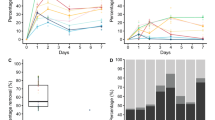Abstract
Some fungi are able to control and remediate arsenic (As)-contaminated soil, sediment, or water. Here, we investigate potential accumulation and volatilisation of As by three fungi strains. Results indicated that the highest level of As was accumulated by Penicillin janthinellum with 39.54 μg after 10 days in the culture system amended with 2,500 μg As(V), which represents 50 mg/l As. Fusarium oxysporum showed the highest amount of volatilised As with 304.06 μg after 15 days. The As content in the treated system (filter paper + As + fungi) was significantly higher than that in the control (filter paper + As; filter paper + fungi; filter paper). Trichoderma asperellum and F. oxysporum showed superior abilities for the absorption of extracellular As and accumulation of intracellular As, which accounted for 82.2 and 63.4% of the total accumulated As, respectively. However, P. janthinellum presented an equal distribution of intracellular and extracellular As. Scanning electron microscope (SEM) analysis suggested that little impact on mycelium growth of the three fungal strains was seen after exposure to 50 mg/l As(V) for 5 days, while the growth of fungi in the control was inhibited. The present results demonstrate that P. janthinellum, F. oxysporum, and T. asperellum would be expected to tackle As-contaminated environments.




Similar content being viewed by others
References
Asensio L, Lopez-Llorca LV, López-Jiménez JA (2005) Use of light, scanning electron microscopy and bioassays to evaluate parasitism by entomopathogenic fungi of the red scale insect of palms (Phoenicococcus marlatti Ckll., 1899). Micron 36:169–175
Bentley R, Chasteen TG (2002) Microbial methylation of metalloids: arsenic, antimony, and bismuth. Microbiol Mol Biol Rev 66:250–271
British Geologic Survey/Department of Public Health and Engineering (2000) Groundwater studies for arsenic contamination in Bangladesh, final report, summary, Dhaka, Bangladesh
Carrasco JA, Armario P, Pajuelo E et al (2005) Isolation and characterization of symbiotically effective Rhizobium resistant to arsenic and heavy metals after the toxic spill at the Aznalcóllar pyrite mine. Soil Biol Biochem 37:1131–1140
Čerňanský S, Kolenčík M, Ševc J et al (2009) Fungal volatilization of trivalent and pentavalent arsenic under laboratory conditions. Bioresour Technol 100:1037–1040
Čerňanský S, Urík M, Ševc J et al (2007) Biosorption and biovolatilization of arsenic by heat-resistant fungi. Environ Sci Pollut Res 14:31–35
Challenger F (1945) Biological methylation. Chem Rev 36:315–361
Challenger F, Higginbottom C (1935) The production of trimethyl-arsine by Penicillium brevicaule (Scopulariopsis brevicaulis). Biochem J 29:1757–1778
Dahal BM, Fuerhacker M, Mentler A et al (2008) Arsenic contamination of soils and agricultural plants through irrigation water in Nepal. Environ Pollut 155:157–163
Franklin NM, Stauber JL, Apte SC et al (2002) Effect of initial cell density on the bioavailability and toxicity of copper in microalgal bioassays. Environ Toxicol Chem 21:742–751
Gosio B (1892) Action of microphytes on solid compounds of arsenic: a recapitulation. Science 19:104–106
Granchinho SCR, Franz CM, Polishchuk E et al (2002) Transformation of arsenic(V) by the fungus Fusarium oxysporum melonis isolated from the alga Fucus gardneri. Appl Organomet Chem 16:721–726
Karna RR, Sajani LS, Mohan PM (1996) Bioaccumulation and biosorption of CO2+ by Neurospora crassa. Biotechnol Lett 18:1205–1208
Páez-Espino D, Tamames J, Lorenzo VD et al (2009) Microbial responses to environmental arsenic. Biometals 22:117–130
Pearce RB, Callow ME, Macaskie LE (1998) Fungal volatilization of arsenic and antimony and the sudden infant death syndrome. FEMS Microbiol Lett 158:261–265
Rosen BP (1999) Families of arsenic transporters. Trends Microbiol 7:207–212
Solozhenkin PM, Nebera VP, Medvedeva-Lyalikova NN (1999) Transformation of arsenic and tellurium in solution by fungi. Process Metall 9:779–787
Song HB, Fan HQ, Yang LY et al (2005) Research on biovolatilization of arsenic from contaminated soil. Res Environ Sci 18:61–63
Thompson-Eagle ET, Frankenberger WT, Karslon U (1989) Volatilization of selenium by Alternaria alternate. Appl Environ Microbiol 55:1406–1413
Thompson-Eagle ET, Frankenberger WT (1992) Bioremediation of soils contaminated with selenium. In: Lal R, Stewart BA (eds) Advances in soil science. Springer, New York, pp 261–309
Visoottiviseth P, Panviroj N (2001) Selection of fungi capable of removing toxic arsenic compounds from liquid medium. Sci Asia 27:83–92
Volesky B (1994) Advances in biosorption of metals: selection of biomass types. FEMS Microbiol Rev 14:291–302
Wei CY, Chen TB (2002) The ecological and chemical characteristics of plants in the areas of high arsenic levels. Acta Phytoecl Sin 26:695–700
Acknowledgements
We acknowledge the Natural Science Foundation of China (No.: 40871102) and the National Scientific and Technological Program of “11th Five-Year” Plan of China (No.: 2006BAD05B01 and No.: 2007BAD89B03) for their financial support.
Author information
Authors and Affiliations
Corresponding author
Rights and permissions
About this article
Cite this article
Su, S., Zeng, X., Bai, L. et al. Bioaccumulation and Biovolatilisation of Pentavalent Arsenic by Penicillin janthinellum, Fusarium oxysporum and Trichoderma asperellum Under Laboratory Conditions. Curr Microbiol 61, 261–266 (2010). https://doi.org/10.1007/s00284-010-9605-6
Received:
Accepted:
Published:
Issue Date:
DOI: https://doi.org/10.1007/s00284-010-9605-6




